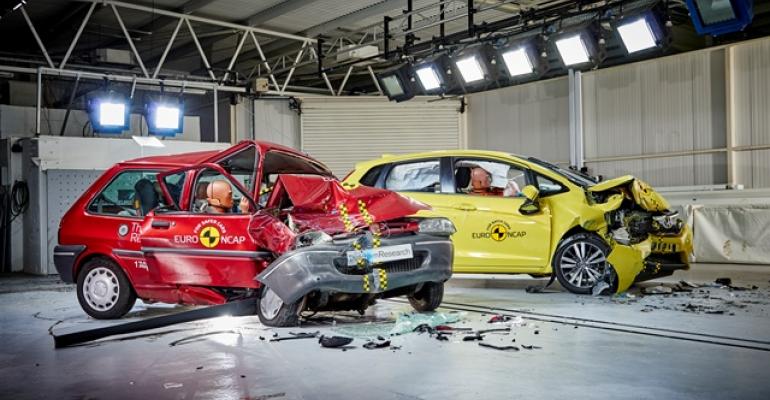More than 182,000 deaths and serious injuries have been prevented on U.K. roads since the European New Car Assessment Program (Euro NCAP) car safety tests were launched 20 years ago. This equates to 15,000 per year.
Thatcham Research, which conducts U.K. crash tests for Euro NCAP, estimates that advances driven by rigorous testing have helped deliver a 63% reduction in car occupants killed and seriously injured annually, from 23,000 in 1997 to 8,500 in 2015.
Over the same period, the number of pedestrians and cyclists killed or seriously injured has fallen 40%, from 14,500 in 1997 to 8,500 in 2015.
In the process, Euro NCAP has gone from controversial to firmly part of the automotive mainstream.
Thatcham Research, the U.K.’s independent voice of automotive safety, is marking its 20th anniversary by urging consumers to further boost Britain’s road safety record by buying only models with a 5-star Euro NCAP rating and collision-avoidance technology such as automatic emergency braking and lane-assist systems.
It also is calling on manufacturers to make AEB standard and estimates if that were to occur, 2,700 pedestrian and cyclist deaths and serious injuries would be avoided annually.
Thatcham says the Euro NCAP tests, introduced in February 1997 in the face of fierce auto industry opposition, exposed hidden dangers in top-selling family cars, forcing a fundamental change in the way vehicles are designed to prevent injuries and save lives.
Euro NCAP tests steadily have become more demanding, and cars now can achieve a maximum of five stars, awarded not just for how they protect occupants and pedestrians in a collision, but on the vehicle’s ability to avoid a crash in the first place.
New elements being tested by Euro NCAP for incorporation in the 2018 ratings include lane-keeping-assist systems; testing to reduce crashes at intersections; pedestrian AEB that works at night; and new AEB cyclist-detection tests.
Currently, nine out of 10 cars sold on the European market hold a Euro NCAP rating.
Since 1997, Euro NCAP has assessed 629 different car models. Safety technologies that were non-existent or optional at best – such as driver and passenger airbags, side-curtain airbags, seatbelt reminders and electronic stability control – now are standard on most cars sold in Europe.
Backed by the U.K. government, the Federation Internationale de l’Automobile and the Swedish and Dutch governments, the first Euro NCAP crash test results were revealed on Feb. 4, 1997.
Until then, car makers conducted their own crash tests, but they were not standardized and the results were not published. It was impossible for consumers to compare the safety of one car with another.
Thatcham Research CEO Peter Shaw says at the start, leading car manufacturers attacked the Euro NCAP tests, claiming they were so severe that it was impossible to achieve the maximum four stars. But five months later, Volvo’s S40 became the first 4-star car for occupant protection.
Now, Shaw says, manufacturers compete to out-perform rivals in Euro NCAP testing and regularly use the ratings in their advertising.





